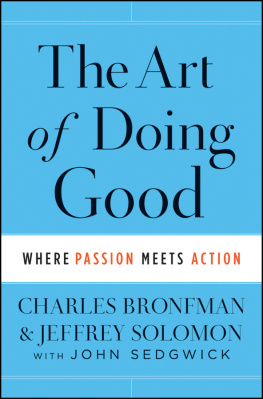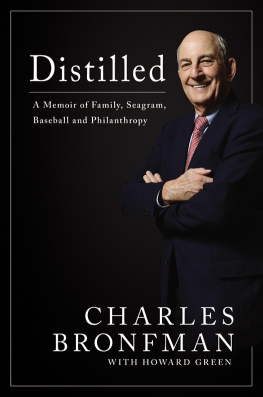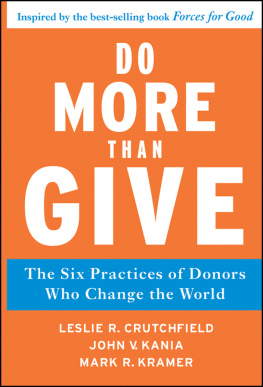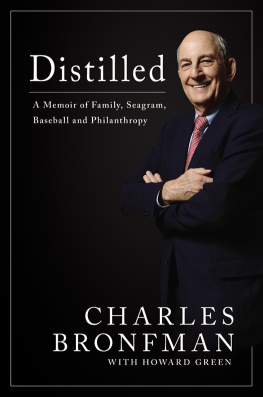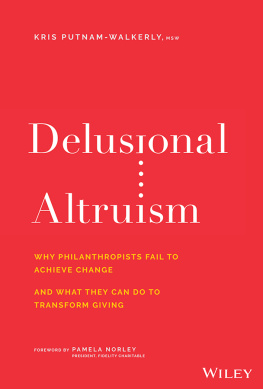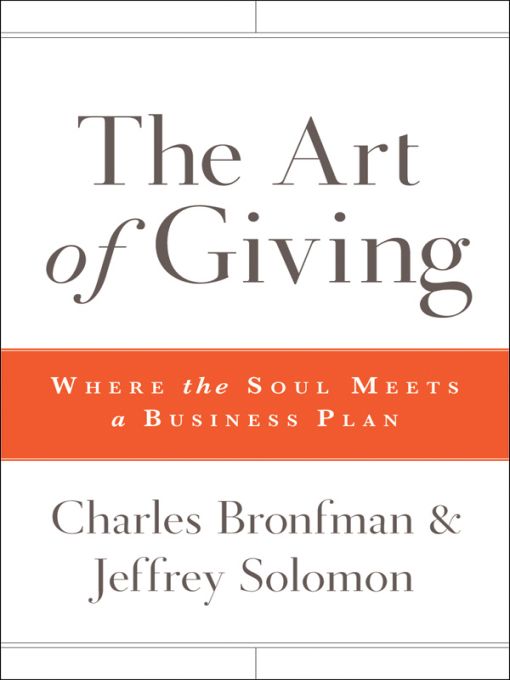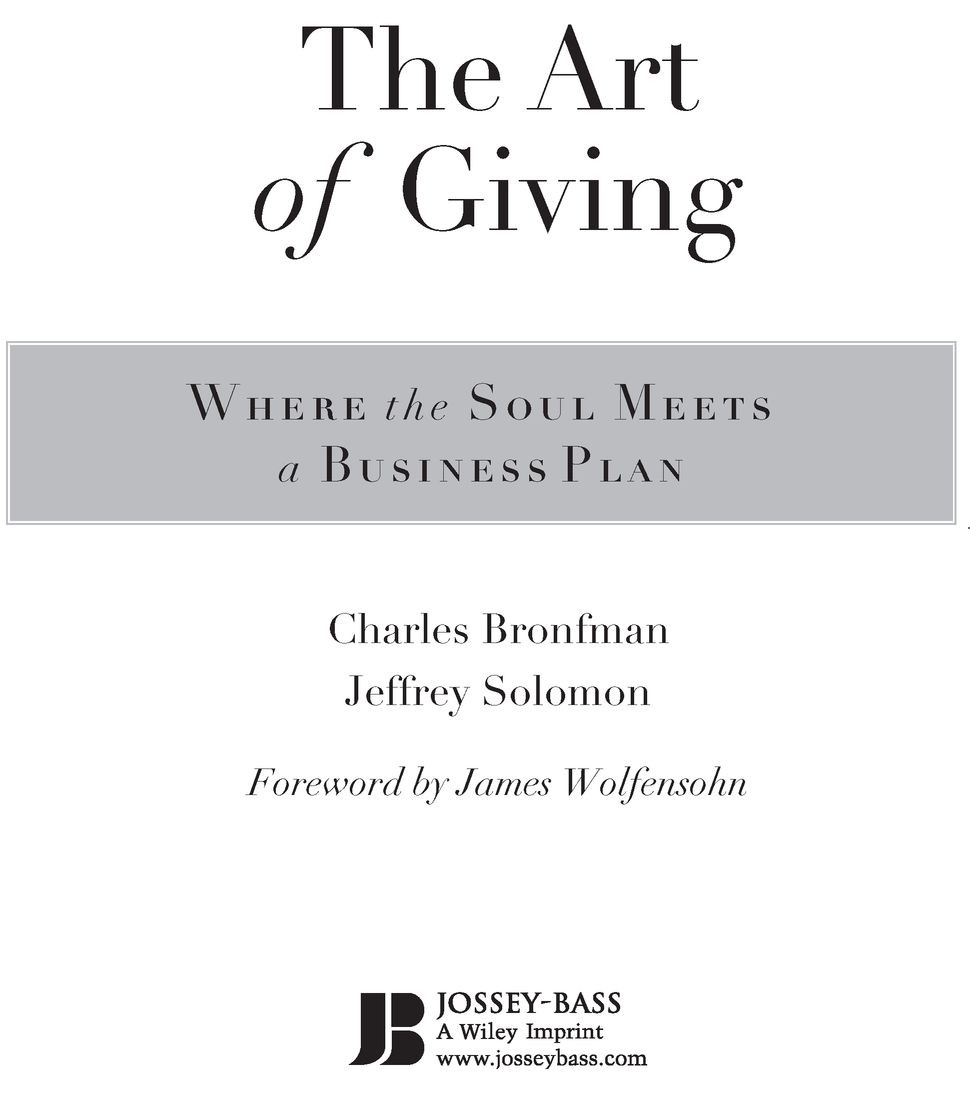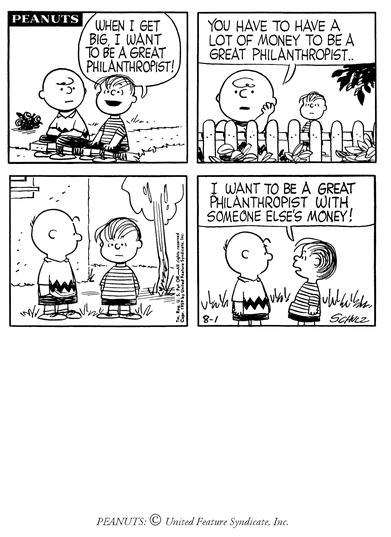Table of Contents
In memory of our parents:
Saidye and Sam
Herta and Martin
whose values taught us to do our best in making
the world a better place.
And in honor of our grandchildren:
Alexandra, Danielle, Lila, Lucy, Olivia, and Rainen
Samuel, Scott, Talia, and Zack
who we know will continue the tradition to which
their parents are also committed.
FOREWORD
IF PHILANTHROPY IS THE LOVE OF MANKIND, then it is apt that this fine and helpful book should be dedicated to this subject, for it demonstrates its own love for humanity on every page. I do not mean love of the folksong variety that one sometimes encounters in charity work, but one that is more like tough love: it takes on the hard issues of a difficult trade in an unsentimental and clear-minded way, and it offers novel and compelling suggestions about ways that money, wisely applied, can make the world a better place. It is hard to imagine a potential donor who would not benefit from the insights of this book or to think of a veteran donor who wont wish that the book had been available sooner.
For all of its universality, to say nothing of its potency, philanthropy is little understood by the general public, or even by its practitioners. This book should go some way to change all that. And we owe a debt to Charles Bronfman and Jeffrey Solomon, who have been practitioners in the field for over a half-century between them, for setting down their ideas in such a fresh and readable fashion.
People who know nothing about philanthropy assume that it is easy. You reach into your wallet to pull out some cash for a small gift or write a check for a large one. Deliver the money to the recipient of your largess, and the work is done. Well, those of us who are in the business know that what has more likely just occurred is a waste of resources. Philanthropy cannot be so casual. It must be purposeful. It must connect.
Philanthropy involves both dreams and plans. You have to be inspired, and you have to be sensible. So many philanthropists miss this duality, erring too far in one direction or the other. But Bronfman and Solomon get it exactly right.
On the sensible side of the ledger, they are fierce advocates of measurement, a source of some controversy in the charitable community, which can be somewhat averse to hard numbers. As is often said, nonprofits have no bottom line, no easily recognizable and universally recognized measure of success. So they depend on other measures, often inconsistent and subjective, by which to determine when they are doing well and when they are doing badly. In insisting that nonprofits create and heed common measures of performance, Bronfman and Solomon are applying a welcome realism to a business sector that all too often lacks it completely.
The element of the book that is most inspiring is the one that is possibly the most daring: the authors wise observation that philanthropy starts with you. Your feelings. Your dreams. Your values. And it makes you part of a broader world. By supporting causes outside your daily life, you not only do good for others, but you benefit by your involvement in the broader world in which we live. You learn about foreign lands, people of all types, and important causes, and you meet an extraordinary group of people. The act of giving is in fact a gift to oneself. Too many donors feel ashamed, or are made to feel ashamed, if they feel any personal gratification for the gifts they make. They are supposed to be selfless, a very odd notion if you think about it, as few people are on a regular basis. Just like any investor, donors are entitled to personal satisfaction for their financial contributions. And as Bronfman and Solomon point out, the pleasure that they take is their just reward for what they do, and it is also the source of their sustaining connection to the cause. It is what makes their work worth doingfor society and for them.
The big secret of philanthropy is now out. Philanthropy is fun. It is joyful. It is fulfilling. It will make your life feel worthwhile in ways that few other enterprises can.
Let this book show you how.
August 2009
New York City
James Wolfensohn
INTRODUCTION
Who We Are
TO MANY PEOPLE, THE WORLD OF NONPROFITS is like the dark side of the moon: mysterious, remote, and subject to unusual forces. We have spent a half-century working in this realm and hope this book will shed some light on the strange enterprise of doing good. We do this primarily for the sake of potential donors, who are, after all, essential to philanthropy. Without donors, there would be no philanthropy at all. No private universities, many fewer hospitals, no places of worship, precious few museums, and infinitely fewer programs for the poor, the arts, the elderly, the environment.
Despite their centrality, donors have few resources for solid information about making their giftsdeciding what the right gift is for them, how to structure it, how to consider the tax implications, and countless other complexities. And then there is the emotional aspect. Few donors are selfless, and that is fine. The question is, What self governs these philanthropic choices, or what portion of that self? Where does the donors deep passion reside? What is he or she hoping to accomplish? Too often philanthropic gifts are made out of social or business obligation, guilt, or whim, which takes all the urgency and meaning out of them, to say nothing of the fun.
To give is a sweet verb. But it also runs counter to some basic human impulsesso counter, in fact, that we tend to think of the nonprofit world as the negative economy, an upside-down world where philanthropies are inverted versions of actual businesses or industries, spending money without making it. That mistaken idea leads to many others about the peculiar notion of existing to serve others and measuring success in terms other than dollars.
Such attitudes place philanthropy in a special preserve and require a special understanding. With this book, were hoping to instruct donors, and would-be donors, on some of the truths of our trade, like the nature and definition of progress, the proper balance between ambition and resources, how to sort through the overwhelming number of opportunities, and such abstruse but essential matters as board governance and tax liabilities. Philanthropy can also be addictive. Where the donors money goes, her heart is likely to follow.
We have divided this book into four parts to cover the essential elements that the donor needs to understand in order to make the most effective and satisfying gifts. Part One, The Donor, is about just that: the donor herself. We situate her in the new philanthropic era, helping to identify her most authentic motivation, seeing where she fits within the wide range of donors, and guiding her as she selects the perfect gift to make. Of the three parts, it is the most psychological, since it necessarily delves into the soul where, we will argue, the essential motivations lie. This is not a book defining how you ought to do philanthropy. It is about discovering how you want to do philanthropy.


